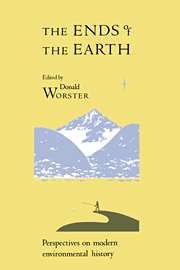Appendix: Doing Environmental History
Published online by Cambridge University Press: 05 June 2012
Summary
In the old days, the discipline of history had an altogether easier task. Everyone knew that the only important subject was politics and the only important terrain was the nation-state. One was supposed to investigate the connivings of presidents and prime ministers, the passing of laws, the struggles between courts and legislatures, and the negotiations of diplomats. That old, self-assured history was actually not so old after all – a mere century or two at most. It emerged with the power and influence of the nation-state, reaching a peak of acceptance in the nineteenth and early twentieth centuries. Often its practitioners were men of intensely nationalistic feelings, who were patriotically moved to trace the rise of their individual countries, the formation of political leadership in them, and their rivalries with other states for wealth and power. They knew what mattered, or thought they did.
But some time back that history as “past politics” began to lose ground, as the world evolved toward a more global point of view and, some would say, toward a more democratic one. Historians lost some of their confidence that the past had been so thoroughly controlled or summed up by a few great men acting in positions of national power. Scholars began uncovering long submerged layers, the lives and thoughts of ordinary people, and tried to reconceive history “from the bottom up.” Down, down we must go, they maintained, down to the hidden layers of class, gender, race, and caste.
- Type
- Chapter
- Information
- The Ends of the EarthPerspectives on Modern Environmental History, pp. 289 - 308Publisher: Cambridge University PressPrint publication year: 1989
- 15
- Cited by

